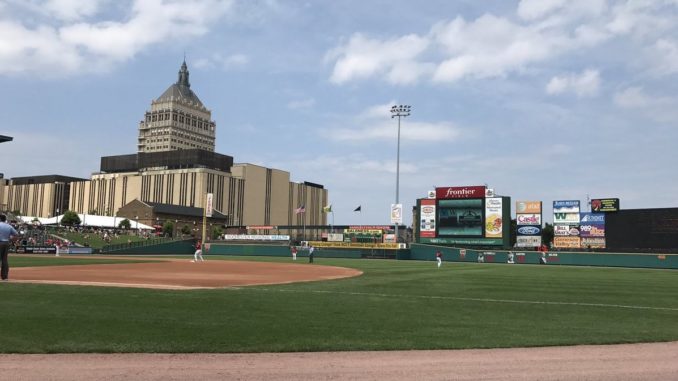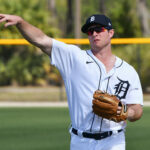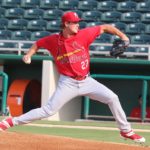
While stats alone will never tell you the complete picture of a player or perfectly predict his future performances, they can still tell you a lot about that player when putting his performance into the context of league average benchmarks. The tables below are meant to be a reference for this type of analysis. Of course, there are many other statistics available that could be included beyond those presented here. For the sake of accessibility and brevity, I included only generally well-known or intuitive statistics that broadly represent a player’s offensive or pitching profile. These numbers should stay roughly the same for 2022 barring any significant external changes. MLB averages were also included for comparison purposes.
All data is sourced from Fangraphs except where otherwise noted. See the glossary for an explanation of all stats included in the tables. Only batters with at least 100 AB and pitchers with at least 30 IP were included.
Update 3/7/2022: A previous version of the article speculated on why the Strike% and SwStr% data for the Rookie levels were markedly higher than the rates at the higher levels and MLB. It has come to my attention that this difference exists due to limitations with the pitch scoring system used at those levels and not due to any difference in play. Thank you to Daniel Victor (@slydanno70 on Twitter) for the tip.
2021 Batter Averages (Min. 100 ABs): Rookie Leagues, Full-Season Minor Leagues, and MLB
|
Statistic |
Rookie (DSL) |
Rookie (CPX) |
Low-A |
High-A |
AA |
AAA |
MLB |
|
Age |
17.8 |
19.2 |
21.2 |
22.7 |
24.1 |
26.4 |
*27.9 |
|
AVG |
.244 |
.248 |
.246 |
.245 |
.244 |
.255 |
.242 |
|
BABIP |
.312 |
.333 |
.325 |
.316 |
.308 |
.311 |
.290 |
|
OBP |
.351 |
.341 |
.340 |
.331 |
.327 |
.338 |
.315 |
|
SLG |
.352 |
.389 |
.390 |
.411 |
.404 |
.431 |
.407 |
|
OPS |
.703 |
.729 |
.731 |
.742 |
.731 |
.769 |
.722 |
|
SB% |
68.6% |
69.6% |
72.3% |
71.8% |
67.9% |
69.8% |
73.0% |
|
BB% |
11.9% |
10.6% |
10.9% |
9.9% |
9.5% |
9.9% |
8.7% |
|
K% |
21.6% |
26.8% |
26.3% |
26.6% |
25.6% |
23.6% |
23.2% |
|
SwStr% |
29.0% |
29.9% |
13.8% |
13.4% |
12.9% |
12.1% |
11.4% |
|
*Contact% |
69.7% |
68.0% |
69.4% |
68.9% |
70.5% |
72.7% |
78.7% |
|
GB% |
44.6% |
44.4% |
43.4% |
42.2% |
41.5% |
42.3% |
42.5% |
|
LD% |
19.2% |
18.5% |
22.1% |
19.7% |
20.9% |
20.8% |
20.7% |
|
FB% |
36.2% |
37.2% |
34.5% |
38.0% |
37.6% |
36.9% |
36.8% |
|
HR/FB% |
5.5% |
9.7% |
11.0% |
13.1% |
13.2% |
14.0% |
13.2% |
|
Pull% |
48.1% |
46.9% |
44.2% |
44.0% |
44.8% |
44.2% |
40.4% |
|
Cent% |
21.9% |
22.9% |
24.6% |
24.5% |
24.3% |
24.6% |
34.8% |
|
Oppo% |
30.0% |
30.2% |
31.1% |
31.5% |
30.9% |
31.1% |
24.8% |
*Contact% sourced from Rotowire. MLB Age sourced from Baseball Prospectus.
For the most part, many averages remain fairly consistent across all levels of MLB-affiliated baseball. However, there are a couple of notable outliers to be aware of. In the Rookie leagues, the swinging strike rates are much higher than the averages for full-season ball. This is due to a difference in the way that pitches are scored and tracked in the Rookie levels as opposed to full-season ball and MLB. Unfortunately, this renders the data useless for prospect analysis.
The level with the lowest amount of offensive production appears to be at AA. In contrast, there is a noticeable increase in offensive production at AAA. This is likely due to the use of the major league ball at AAA, which has more life than the minor league balls used at the lower levels. This is reflected in the AAA power indicators such as slugging percentage and home run per flyball rates which are higher than any other level.
The data also show that MLB batters tend to hit the ball to center field much more frequently than at any other level. This could be a result of MLB batters having generally better swing timing than minor league batters. The MLB averages for swinging strike rates and contact rates support the notion that MLB batters have more refined plate approaches than minor league batters on average, which could in turn explain the difference in MLB spray distributions.
2021 Pitchers (Min. 30 IP): Rookie Leagues, Full-Season Minor Leagues, and MLB
|
Statistic |
Rookie (DSL) |
Rookie (CPX) |
Low-A |
High-A |
AA |
AAA |
MLB |
|
Age |
18.8 |
19.8 |
21.9 |
23.3 |
24.6 |
27.2 |
*28.6 |
|
ERA |
3.60 |
4.93 |
4.61 |
4.49 |
4.28 |
4.77 |
4.18 |
|
WHIP |
1.27 |
1.44 |
1.42 |
1.34 |
1.33 |
1.41 |
1.29 |
|
BABIP |
.297 |
.328 |
.319 |
.307 |
.303 |
.307 |
.286 |
|
LOB% |
65.8% |
64.5% |
66.2% |
68.3% |
71.1% |
70.1% |
72.9% |
|
BB% |
9.7% |
9.9% |
10.7% |
9.7% |
9.5% |
9.7% |
8.9% |
|
K% |
23.8% |
26.8% |
26.1% |
26.9% |
25.9% |
23.8% |
23.7% |
|
K-BB% |
14.1% |
15.2% |
15.5% |
17.2% |
16.4% |
14.1% |
14.8% |
|
Strike% |
73.2% |
73.8% |
62.2% |
63.1% |
63.3% |
62.8% |
63.9% |
|
SwStr% |
33.0% |
28.8% |
13.7% |
13.4% |
13.0% |
12.0% |
11.5% |
|
GB% |
45.9% |
44.0% |
44.0% |
42.9% |
41.8% |
42.8% |
42.9% |
|
LD% |
18.6% |
18.7% |
21.7% |
19.5% |
20.5% |
20.8% |
20.4% |
|
FB% |
35.5% |
37.2% |
34.2% |
37.7% |
37.7% |
36.4% |
36.8% |
|
HR/FB% |
4.7% |
10.5% |
10.4% |
12.2% |
12.6% |
13.9% |
13.2% |
|
Pull% |
47.7% |
46.9% |
43.6% |
43.7% |
44.2% |
43.5% |
39.8% |
|
Cent% |
21.7% |
23.5% |
24.7% |
24.2% |
24.3% |
24.5% |
34.9% |
|
Oppo% |
30.6% |
29.6% |
31.6% |
32.1% |
31.5% |
32.0% |
25.3% |
*MLB Age sourced from Baseball Prospectus.
As is to be expected, most of the statistical averages listed for pitchers roughly mirror the averages for batters. One interesting item to note is that pitchers are roughly six months older on average than their batter counterparts.
Like the batters, the pitcher averages for AAA reflect a general increase in offensive production before falling off again in MLB as shown in the averages for ERA and WHIP, as well as the power indicators mentioned for the batters. Again, the swinging strike rates for pitchers are much higher in the Rookie leagues compared to the full season minors and MLB. Additionally, the strike rates for Rookie league pitchers are also much higher, due to the same issue in pitch scoring and tracking mentioned before. As before, these data are not reliable for prospect analysis.
Glossary (Alphabetical)
AVG: Batting average (Hits / ABs)
BABIP: Batting average of balls in play (Hits / Balls in play)
BB%: Walk rate (Walks / PAs)
Cent%: Center rate (Hits in the center of the field / Hits)
Contact%: Contact rate (Number of pitches where contact was made / Total pitches)
ERA: Earned run average (Earned runs allowed / (Innings pitched x 9))
FB%: Flyball rate (Flyballs / Balls in play)
GB%: Groundball rate (Groundballs / Balls in play)
HR/FB%: Homerun per flyball rate (Homeruns / Flyballs)
K%: Strikeout rate (Strikeouts / ABs)
K-BB%: Strikeout rate – Walk rate
LD%: Line drive rate (Line drives / Balls in play)
LOB%: Left on base rate (Baserunners – Runs allowed / Baserunners)
Pull%: Pull rate (Hits on the same side of the field on which the batter hits / Hits)
OBP: On-base percentage (Hits + Walks + Hit by Pitch) / (At Bats + Walks + Hit by Pitch + Sacrifice Flies)
Oppo%: Opposite field rate (Hits on the opposite side of the field on which the batter hits / Hits)
OPS: On-base + slugging percentage
SB%: Stolen base success rate (Stolen bases / Stolen base attempts)
SLG: Slugging percentage ((1B + 2Bx2 + 3Bx3 + HRx4)/AB)
Strike%: Strike rate (Strikes called / Total pitches)
SwStr%: Swinging strike rate (Swinging strikes / Total pitches)
WHIP: Walks + Hits / Innings pitched
Doug Otto is the High-A Central league correspondent and Arizona Diamondbacks correspondent for Prospects1500. He is an avid follower and consumer of prospect news, rankings, and data. He also has experience playing fantasy baseball, mostly in deep dynasty formats. When Doug isn’t researching prospects, he’s either watching movies or baking dessert. He can be found on Twitter at
@hdouglasotto





Leave a Reply